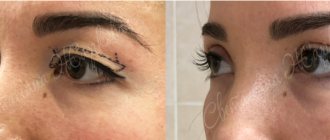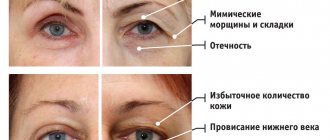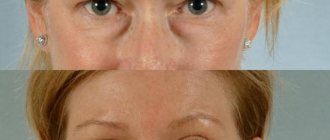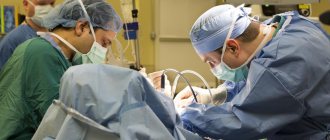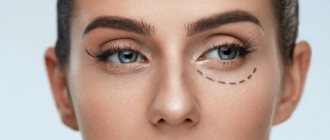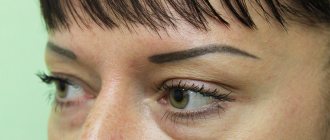06.03.2020
Blepharoplasty is a surgical operation that corrects the shape of the eyelids and the shape of the eyes. The surgeon removes areas of skin, fat layer of the lower and upper eyelids, providing a tightening effect.
The skin in this area ages first and the eyelid droops due to loss of elasticity. After 30 years, subcutaneous fat tissue also undergoes dystrophic changes - it grows and begins to sag. The look becomes tired and expressionless.
Therefore, women and men aged 40–45 who want to eliminate these cosmetic defects most often apply for blepharoplasty. By lifting the skin, the look becomes more open and the face appears younger.
Aesthetic indications for blepharoplasty
Blepharoplasty solves the following problems:
- excessive sagging of the skin of the upper eyelid;
- hernias of the lower eyelids - so-called bags under the eyes. This is a layer of fatty tissue accumulated in one place. Due to age or genetics, connective tissue septa cease to hold the lipid layer, and it begins to bulge;
- drooping corners of the eyes;
- eye asymmetry;
- sprain of the orbicularis oculi muscle;
- blepharochalasis - skin atrophy, as a result of which small wrinkled folds form above the eyelid;
- exophthalmos - excessive protrusion of the eyeball, bulging eyes;
- epicanthus - an additional fold at the inner corner of the eyelid (“Mongolian fold”).
If necessary, the plastic surgeon can slightly change the shape of the eyes.
What do experts think?
Bytdaev Zaur Makhrovich, plastic surgeon, candidate of medical sciences:
In my practice, after the recovery period there was no such problem, but immediately after the operation it can appear due to varying degrees of swelling. In order to get rid of this condition as quickly as possible, there is a list of measures that can effectively resolve the issue, including physical therapy. True, it is necessary to take into account that there is a congenital asymmetry, which is actually visible, but it can also be corrected.
Eye size difference
During the first month after surgery, differences in eye size can be considered normal. In order for everything to go smoothly, you need to strictly follow the surgeon’s recommendations and go for repeated examinations, since the doctor must monitor the rehabilitation process. If, upon completion of rehabilitation, no positive dynamics are observed, then this is considered a complication.
The first thing a patient should do in such a situation is to go to his surgeon to identify the causes and find a solution. Repeat blepharoplasty, canthoplasty, and other types of surgery may be necessary.
Aleksanyan Tigran Albertovich, plastic surgeon, candidate of medical sciences:
Eyes of different sizes occur when the operation is performed incorrectly or when the face is very uneven. I believe that first you need to choose the right surgeon, who has been performing such operations for a long time and knows how to do it, so as not to encounter unpleasant consequences in the end. Otherwise, you will have to do a second operation, which makes correcting the consequences much more difficult.
Levin Sergey Lvovich, plastic surgeon, Doctor of Medical Sciences:
Usually, in any person, the eyeball is more recessed on one side, and more protruding on the other and visually appears larger - this is a normal phenomenon. After upper eyelid surgery, the difference sometimes becomes more noticeable.
Another main factor is that after the operation the patient examines himself longer and more closely in front of the mirror and finds that asymmetry that he did not notice before. A less pleasant option is that if too much skin around the eyes has been excised, then the difference in the depth of their seating may be increased. And it can't be fixed.
Egorova Maria Vladimirovna, chief plastic surgeon at Frau Klinik:
Initially, the human skull as a whole and the eyes are asymmetrical. But almost no patient notices this. After surgery, a difference may occur due to close attention to the area as well as swelling. In general, recovery lasts 6 months; during this time, various complaints may arise regarding the operated area, which does not require additional intervention.
Different eyes are a complication if asymmetry was obtained due to incorrectly performed blepharoplasty. In some situations, correction is possible, but its feasibility can only be determined during a face-to-face consultation with a surgeon.
YouTube responded with an error: The request cannot be completed because you have exceeded your quota.
Rate this article:
- Related Posts
- Rules for treating chemosis with drugs after blepharoplasty
- How to get rid of dark circles under the eyes after blepharoplasty?
- What complications can occur after blepharoplasty?
- Why do my eyes itch after blepharoplasty?
- How to remove seals on the lower eyelid after blepharoplasty?
- Can hollows form under the eyes after blepharoplasty?
Medical indications for blepharoplasty
An ophthalmologist will send you for reconstructive blepharoplasty if it is determined that the structure of the eyelids interferes with the functioning of the visual apparatus. Indications may be:
- ptosis of the upper eyelid - its abnormally low location;
- severe narrowing of peripheral vision due to excessive overhang of skin folds;
- entropion - inversion of the eyelid, when the eyelashes and its edge are turned towards the eyeball;
- ectropion - inversion of the tissues of the lower and upper eyelids outward.
Blepharoplasty has moved into the arsenal of plastic surgeons from ophthalmology, where similar interventions were carried out back in the century before last. However, modern technologies have made it possible to classify blepharoplasty as a one-day operation: after it, the patient can return home the next day.
Reasons for appearance
The negative effect on the surface layer of the conjunctiva can be of a different nature, therefore the following conditions result from the appearance of chemosis:
- traumatic impact (foreign body, chemical or thermal burn, exposure to ultraviolet radiation, dust or dry air);
- allergies (house dust, plant pollen, animal dander);
- conjunctivitis is an infectious disease of the conjunctiva that is viral, bacterial, or fungal in nature;
- blepharitis - inflammation of the edges of the eyelids, which is formed due to infection with Demodex mites, viruses, bacteria, fungi;
- meibomitis - the formation of an abscess in the inner or outer part of the eyelid due to inflammation of the sebaceous glands;
- eyelid abscess - the formation of infiltrative purulent inflammation in a specific part of the eyelid, due to the limitation of the affected area;
- exophthalmos – displacement of the eyeball forward or to the side, most often considered a sign of serious diseases, ocular or systemic;
- vascular pathologies;
- tumors of the periorbital zone - swelling in the area of the eye orbit, which appears as a result not only of eye lesions, but also causes pathologies of the brain or the whole body;
- Chemosis can be a complication after blepharoplasty.
We recommend: How do scars heal after blepharoplasty?
This disease is considered a sign of serious eye problems and always requires serious examination and timely treatment. One of the most common causes of chemosis is considered to be allergic reactions, sometimes resulting from the uncontrolled use of medications.
Before and after surgery: photos
Types of blepharoplasty
Tell the surgeon in detail about your expectations from permanent blepharoplasty - the doctor will take into account your anatomical features and select the optimal surgical technique. All classical technologies involve incisions with a surgical scalpel.
Upper or anchor blepharoplasty
Upper eyelid blepharoplasty is the most popular operation. Aimed at removing excess skin, fat or muscle in this area. An experienced VIP Academy surgeon will determine how much tissue needs to be excised so that the eyelids can close properly.
Lower, or subliciary, blepharoplasty
Blepharoplasty of the lower eyelid involves excision of fat bags under the eyes, and, if necessary, the skin stretched over them is removed. Sometimes the desired effect is achieved through the redistribution of fat depots.
Circular blepharoplasty
This is a simultaneous lift of the upper and lower eyelids. It takes place in several stages, lasts longer than other operations (up to 3 hours) and is considered more complex. The technique involves a highly qualified surgeon; the maximum number of defects is eliminated at a time.
Transconjunctival blepharoplasty
The surgeon can make an incision above the upper eyelashes, on the outside of the eyelid, or mini-punctures on the mucous membrane, on the inside. In the latter case, the technology is called transconjunctival. This type of blepharoplasty allows you to achieve a high aesthetic effect, since no stitches are needed at all, which means there will be no scars.
Sometimes eyelid blepharoplasty alone is not enough to correct the defect. It is combined with a surgical facelift in certain areas (frontal, superciliary, infraorbital, zygomatic or cheek areas).
Examination before blepharoplasty
Before blepharoplasty, it is necessary to undergo an examination to determine contraindications to surgery. Mandatory manipulations include:
- general blood and urine tests,
- blood chemistry,
- coagulogram - test for blood clotting,
- tests for HIV, syphilis, hepatitis B and C,
- ECG.
At the VIP Academy, patients must be examined by an ophthalmologist, because blepharoplasty is contraindicated for keratitis, blepharitis, glaucoma, and cataracts.
Contraindications
Blepharoplasty is considered a safe and non-traumatic plastic surgery. However, this rejuvenation method also has a number of contraindications.
CONTRAINDICATIONS
- if a person suffers from chronic and acute diseases of the eyelids, dry eye syndrome;
- with various types of conjunctivitis;
- if there is a history of diseases of the organs of vision;
- if the patient suffers from blepharospasms and increased lacrimation;
- with increased intraocular pressure in the patient;
- if malignant neoplasms were previously discovered in the eye area;
- patients suffering from diabetes;
- in case of an infectious disease of an acute or chronic nature;
- for diseases of the cardiovascular system;
- if the patient is diagnosed with any blood clotting disorders, mental disorders;
- if the patient is a pregnant woman or nursing mother.
How is the operation performed?
The surgeon will treat the eyelids with an antiseptic solution three times, then will delimit the surgical field from the surrounding tissues with sterile material.
Injections of local anesthetic are the only painful part during surgery. While the medicine is being administered, you will feel pain and swelling of the soft tissues of the eyelid. Unpleasant symptoms will be replaced by complete insensitivity within 1–3 minutes.
Upper blepharoplasty
The surgeon will mark the skin of the upper eyelids and mark the incision lines. In upper eyelid blepharoplasty, the tissue is cut 7–9 mm from its edge and excess skin is carefully excised.
Capillary bleeding is stopped with an electrocoagulator - a device for cauterizing damaged vessels. A competent surgeon begins suturing the wound only after the bleeding has sufficiently stopped. Sutures are placed on the upper eyelid with a thin atraumatic needle strictly along the incision line.
Lower blepharoplasty
In lower eyelid blepharoplasty, the incision is made at a distance of 2–3 mm from the ciliary edge.
The skin of the lower eyelid, together with the orbicularis oculi muscle, is carefully moved down a few millimeters, opening access to the hernial sacs. They are excised, after which the skin of the lower eyelids is returned to its original position.
The surgeon excises excess skin folds near the primary incision with a single linear flap.
The last stage of lower blepharoplasty is layer-by-layer suturing of the wound of the lower eyelids. The suture is placed intradermally to avoid scarring and poor alignment of the wound edges. Our surgeons apply cosmetic sutures using modern techniques and achieve high aesthetics.
Rehabilitation
If you neglect the doctor’s recommendations during this period, the surgeon’s efforts may be in vain, and you will not get the desired effect. At first you will have to endure the inconvenience and show discipline.
The first hours after surgery
Within 3 to 4 hours after surgery, the anesthesia will wear off and you will feel mild pain in the eyelid area. You may also be concerned about:
- increased sensitivity to light,
- numbness of areas of the eyelid,
- double vision,
- increased tearfulness.
To relieve symptoms, your doctor will prescribe nonsteroidal anti-inflammatory drugs (NSAIDs). They also have an analgesic effect.
First week after surgery
On days 2–3, swelling of the soft tissues of the eyelid increases. It goes away on its own 5–7 days after blepharoplasty. Excessive swelling will help prevent simple rules:
- exclude from your diet foods that retain moisture in the body - salted, fried and smoked foods;
- reduce the amount of liquid consumed;
- avoid tilting your head and torso;
- do not engage in sports or physical labor;
- Avoid eye strain while reading, working at a computer screen or other gadgets.
These restrictions are lifted within 10–14 days after blepharoplasty. Until the wound on the eyelid has completely healed, you should not use decorative and caring cosmetics - the products can cause an allergic reaction or inflammation.
Sutures from the wound are removed on days 7–9 of the rehabilitation period.
Deferred period
The late rehabilitation period begins 2–3 weeks after blepharoplasty. At this time, the structure of the skin is gradually restored:
- swelling goes away completely;
- redness in the suture area disappears;
- new collagen fibers are formed.
The postoperative scar on the eyelids becomes invisible 1–2 months after blepharoplasty. At this time, you can already use cosmetics, so minor redness can be easily masked.
Complications requiring further correction
Sometimes pathologies after surgery do not appear immediately or have consequences that require further long-term and serious intervention.
It is easy to cope with the early consequences of blepharoplasty; they practically do not require chemical or surgical intervention, but complications that require correction require special attention. There are several such complications.
Scars, scars, cysts, hernias
Scars, scars, cysts and hernias after blepharoplasty can occur as a result of prolonged or improper healing.
Typically, postoperative scars resolve within 3-5 months and become almost invisible if the incisions were made carefully and shallowly.
You can also try a massage with various creams and ointments that improve skin regeneration and suture absorption, but you must first consult with a specialist and wait until the wound has completely healed.
What not to do after blepharoplasty
Eyelid blepharoplasty is a procedure that has minimal risk of complications.
Initial laser or transconjunctival blepharoplasty will help you avoid the extra costs of removing scars and scars, since they do not leave scars at all. Keloid or hypertrophic scars can be removed by injecting special medications directly into the problem area.
To correct normotrophic and atrophic postoperative scars, the following hardware techniques are used:
- Mesotherapy is an injection method for getting rid of skin irregularities.
- Laser resurfacing – safe resurfacing of the face using a laser machine.
- Fractional thermolysis – treats problem areas of the skin “in parts” with fragmented laser radiation.
These scar removal techniques almost never cause additional serious complications for patients, so if there is an urgent need to resort to scar removal, you can use one of them on the recommendation and prescription of an experienced ophthalmologist.
Hernias, as complications after surgery, can ruin the entire result of the operation. The problem of bags under the eyes or other prominent areas may remain unresolved. However, this can be fixed.
First of all, you need to contact a specialist who will conduct a thorough examination. Secondly, you will need to undergo repeat blepharoplasty, which should no longer cause any additional complications.
A cyst is a small benign yellowish tumor with liquid contents inside that appears on healing wounds along the sutures. In itself, it is not dangerous and can atrophy on its own a few months after blepharoplasty (from 3 to 5). If this does not happen, then you need to seek the help of a surgeon and remove the tumor.
Ectropion and blepharoptosis
Mild forms of ectropion, or lower eyelid retraction, do not require surgery and resolve on their own. But if the problem does not go away on its own, you need to seek the help of specialists.
Since the mucous conjunctiva of the eye is not completely closed, infection may enter the inner mucous membrane, as well as excessive tearing due to the inability to completely close the eye and moisturize it.
Blepharoptosis is the upper drooping of the eyelid. This complication in those who have undergone blepharoplasty is extremely rare and occurs mainly in older patients.
As a result of a failed upper eyelid blepharoplasty, an inexperienced or inattentive surgeon accidentally damages the muscle so that it can no longer support the eyelid at its normal level. Only a new operation will help cure blepharoptosis.
Tearing
Profuse lacrimation appears against the background of developing dry eye syndrome (keratoconjunctivitis sicca). Excessive tearing after surgery in patients may occur due to changes in the location of the lacrimal openings against the background of constant dryness of the eye or narrowing of the nasolacrimal canaliculi due to improper healing of the wound.
In this case, a probe is used to expand these tubules, after which tear production returns to normal. If the problem is the movement of the lacrimal openings due to a dry eye caused by a turn of the eyelid, it is necessary to do a second blepharoplasty.
"Hot Eyes"
This phenomenon is directly proportional to tear production. With the “hot eyes” effect, a person feels as if the mucous membrane of the eye is literally burning. Probably, the patient has not yet recovered from previous plastic surgery on the face, the wounds have not healed well enough, and the body has not recovered and become stronger.
The eye cannot close completely, so the mucous membrane is not fully moisturized and dries out, causing severe discomfort. To get rid of the discomfort, you need to do blepharoplasty again.
Eye asymmetry
Another fairly common problem in patients with unsuccessful blepharoplasty is eye asymmetry. This phenomenon occurs due to uneven application of sutures and improper scarring of the tissue. “Different eyes” after blepharoplasty can only be eliminated by repeated surgery.
Dry eye syndrome
Keratoconjunctivitis sicca is accompanied by almost all unsuccessful eye surgeries, so blepharoplasty was no exception. With this disease, the eye also becomes very dry, tears are not released or quickly evaporate. The problem is usually further aggravated by dust and smoke in the environment.
Diploma
Upon graduation, the patient begins to experience double vision. This symptom is caused by damage to the eyeball muscle during a failed blepharoplasty surgery. In this case, only immediate surgical intervention and restoration of the integrity of the damaged muscles will help restore the sharpness.
Deterioration of vision
Deterioration of vision is a consequence that can result from all the complications that arise after blepharoplasty taken together. Swelling, hematomas, “hot eye” syndrome or dry keratoconjunctivitis affect the eyeball and retina, which is why they can lead to destruction of the mucous membrane of the eye and retina. Therefore, complications that arise should be treated as soon as possible to avoid more serious consequences.
Cones
After blepharoplasty, lumps often appear in the suture area. They have different shapes and sizes. Depending on the type there are:
- Cysts. They are dangerous and require removal.
- Pyogenic granulomas.
- Scar tissue.
- Local swelling.
- Fat lumps
- Bulging of the eyelid.
As a result, if lumps form in the eye area after surgery, it is important to consult a specialist. This is due to the fact that such a symptom can indicate both the normal course of the rehabilitation period and the occurrence of complications.
Bruises
Bruising after surgery is common. The cause of their occurrence is injury to the blood vessels in the eye area. That is why, immediately after surgery, blue discoloration and swelling are observed on the skin.
The appearance, size and shade of bruises depend on the extent and type of surgery. They appear within 7-10 days after the procedure. They often have a pronounced red color, gradually becoming purple.
When the bruise goes away, it takes on a yellowish or greenish tint. Bruising completely disappears after 6-8 weeks, depending on the individual characteristics of the body.
Dark circles
This type of side effect is not uncommon. Dark circles under the eyes most often occur along with bruises. This is not considered a deviation from the norm.
The cause of their occurrence is damage to small vessels in the eye area. They disappear completely on their own after 3-5 weeks, depending on the individual characteristics of the body.
To speed up the regeneration process, it is recommended to use cold compresses, especially in the first days after surgery.
In some cases, the area around the eyes may become itchy. If the itching is minor, then there is no need to worry. You should consult a specialist if it intensifies and other symptoms appear in the form of pain, watery eyes, redness of the eyes.
Folds and white swellings
The formation of folds and white swellings should not be ignored. Such signs indicate the presence of complications after blepharoplasty of the lower or upper eyelid.
They are often accompanied by eyelid eversion, decreased vision and diplopia. The eyes may itch, itch, and turn red.
The causes of side effects of this type can be an incorrectly performed operation or failure to follow the rules of care during the rehabilitation period. If swelling or folds appear, you should contact a specialist.
In order to avoid the appearance of unpleasant symptoms, you must follow all the recommendations of the plastic surgeon after surgery, avoid exposure to sunlight and temporarily stop using cosmetics.
Possible complications
Most often, complications arise when the patient does not follow the doctor’s recommendations. But the surgical technique, the skill of the surgeon and the individual characteristics of the body are also of great importance.
What shouldn't scare you
Complications of blepharoplasty do not include pain and swelling - this is a physiological reaction of the body in response to trauma to the skin. After lower eyelid blepharoplasty, temporary lower eyelid separation is also possible. After 7–10 days, this phenomenon disappears, and the lower eyelid returns to its place.
What should you be wary of?
True postoperative complications include:
- hematoma formation - occurs if bleeding in the damaged tissues of the eyelid has not been sufficiently stopped;
- dry eye syndrome - tear production is impaired, the surface of the eye is not wetted by tear fluid;
- bacterial conjunctivitis;
- cysts on the suture lines;
- rough scarring of the wound - usually observed in patients prone to keloid formation. In them, any damage to the skin is accompanied by a violent reaction of the body in the form of proliferation of connective tissue.
Only some of the complications of blepharoplasty are considered to be surgical errors:
- violation of eye symmetry;
- eversion or drooping of the eyelid, incomplete closure - occurs when the surgical technique is violated, too large a musculocutaneous flap is excised;
- blindness is an extremely rare complication associated with the formation of a large hematoma in the retrobulbar space. Usually develops in the first hours after blepharoplasty
If you have any doubtful symptoms, contact your doctor immediately. The doctor will distinguish complications from the normal course of the postoperative period and prescribe therapy.
Early temporary complications
Early temporary complications are complications that arise immediately after surgery and usually go away on their own. They occur mainly in the first 2-7 days after the correction, are clearly visible and can cause both mild and noticeable discomfort. These consequences are also divided into several types.
Eversion of the eyelid very often occurs due to the fact that the scar shrinks greatly over time.
To find out the likelihood of such an outcome, you need to consult a doctor. In practice, complications such as eye asymmetry and diplomacy are extremely rare.
Cosmetologist, dermatologist, trichologist
Kalinina Olga Alexandrovna
4 years of experience
Edema
Swelling is a common reaction of the body to any injury or other pathological process. The fact is that increased vascular permeability plays a big role in its occurrence.
Eyelid correction (blepharoplasty) is usually easily tolerated by patients. In the early postoperative period, swelling, sometimes severe, and bruising are observed.
They only cause concern if they do not go away after a week.
More serious complications of eyelid surgery include eyelid inversion, suture dehiscence, scars, scars, infections, watery or dry eyes, blurred vision, folds and blistering of the skin.
These complications require immediate additional correction.
That is, a large amount of liquid blood begins to flow through the vascular wall to the site of injury, which accelerates the healing process. Thus, in the first days after eyelid surgery, swelling is not considered a pathology.
If the rehabilitation week has already passed, and the symptom has not changed in size and has not resolved, it is necessary to contact the surgeon again in order to find out the causes and remove the swelling.
The cause may be inflammatory processes and various factors that slow down the regeneration processes in cells.
Swelling can cause headaches and vision problems such as blurred or double vision.
Hematoma
Another consequence is a hematoma that forms at the site of the operation. The accumulation of blood in one location, just like swelling, can resolve on its own within a short period of time.
Hematomas can be divided into 3 types.
Subcutaneous
This type of hematoma results from the destruction of the vascular wall and the accumulation of blood under the skin, which forms bruises. A simple puncture will help remove excess blood at the site of accumulation.
A coolant, Troxevasin gel and a pressure bandage can be applied to the hematoma. In some cases, it is possible to spread the edges of the wound to remove the liquid part of the hematoma.
Tense
This type is characterized by a larger accumulation of blood under the skin than with a subcutaneous hematoma. Soft tissues are more stretched by liquid, so the help of a specialist is required. Repeated surgical intervention and suturing of the vessel will help solve the problem.
Retrobulbar
Retrobulbar hematoma has the third level of danger in the postoperative period. It forms directly behind the eyeball, over the eyelids of which blepharoplasty was performed, and causes discomfort in a person.
Pain and burning sensations appear, the eye loses the ability of unlimited mobility, the eye protrudes strongly forward. If you notice these symptoms, contact your ophthalmologist immediately.
Eversion of the century
Patients sometimes experience that their eyes cannot close after blepharoplasty. There are a number of reasons for this. Severe and unnatural downward inversion of the eyelid is the result of unsuccessful eyelid blepharoplasty. These changes occur when too much skin is removed during surgery, causing the eyelid to become deformed.
Why can our articles be trusted?
We make health information clear, accessible and relevant.
- All articles are checked by practicing doctors.
- We take scientific literature and the latest research as a basis.
- We publish detailed articles that answer all questions.
Eversion of the eyelid is also accompanied by severe dryness in the eye, since it cannot close completely, and, therefore, there is no complete wetting of the surface of the eye with the back of the eyelid.
In mild stages, surgery is not required. A light massage for the internal rotator cuff muscles and the application of special sutures to support the eye will help.
If the hematoma is large, causes very severe discomfort and correction cannot be achieved using a conservative method, it is necessary to resort to blepharoplasty again.
Dehiscence of sutures and wound edges
Dehiscence of sutures and wound edges is a very common complication after blepharoplasty. In many clinics, in order to avoid unnecessary procedures, they use a self-absorbing suture that leaves no marks.
However, especially with upper eyelid blepharoplasty, the use of absorbable sutures is not advisable. In addition to the possible penetration of infection, there is a danger of divergence of such a suture and the edges of the wound.
It is very easy to damage a seam either independently or if applied incorrectly. If you accidentally rub your eye or touch the wound on something in your sleep, there is a high risk of the wound opening.
Also, if the seam was initially made from low-quality thread or under high tension, it will probably come apart. The wound is then washed, disinfected and sutured again.
The best option would be a self-absorbable suture, which specialists will remove within 6-7 days after application. Lower eyelid blepharoplasty does not require sutures, but they may be needed if the wound is opened.
Result and forecast
The intermediate effect of blepharoplasty can be judged 2–3 weeks after surgery. The final result is assessed 3–6 months later and lasts 8–12 years.
But the skin continues to lose its elastic properties, so sometimes it may be necessary to repeat eyelid blepharoplasty ahead of schedule. In older age groups, it is often combined with a surgical facelift.
A good final effect from blepharoplasty is the result of a constructive dialogue between the doctor and the patient, the doctor’s skill and the correct rehabilitation period.
Eyelid surgery at VIP Academy is safe
Our medical center employs plastic surgeons and ophthalmological surgeons who have already performed more than 5,000 blepharoplasties. take into account the physiology of the entire appendage apparatus of the eyes: muscles, skin and cartilage tissue of the eyelid, subcutaneous tissue and conjunctiva. The doctor accurately determines the amount of intervention in order to achieve a good result and not disrupt the function of the visual organ.
We have a license from Roszdravnadzor to provide plastic surgery services.
Make an appointment with a surgeon by phone or through the website. The manager will answer additional questions via online chat.
Research
Prescription of the necessary treatment is carried out only after interviewing the patient, examining him and passing the necessary tests:
- laboratory tests (conjunctival scraping, bacteria test, blood test);
- ophthalmoscopy;
- biomicroscopy;
- visometry – identification of visual acuity;
- tonometry (measurement of intraocular pressure;
- special studies: ultrasound, CT, x-ray.
We recommend: In what cases is Diprospan needed after blepharoplasty?
Particular attention is paid to differential diagnosis, with the help of which it is possible to exclude such serious diseases as: abscess, tuberculosis of the skin and subcutaneous tissue, the presence of neoplasms, and in case of conjunctivitis, to determine the nature of the infection.

